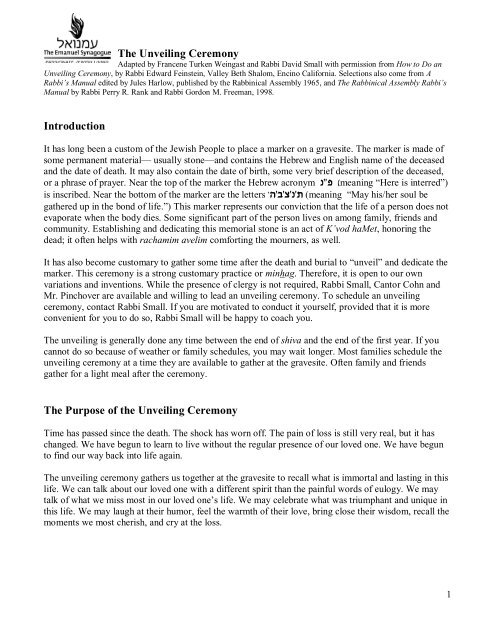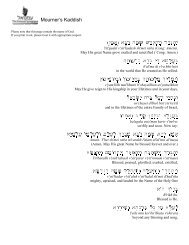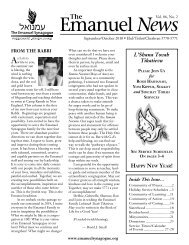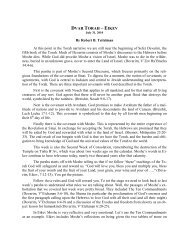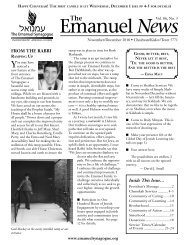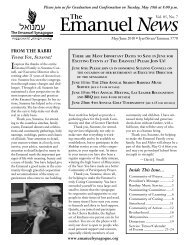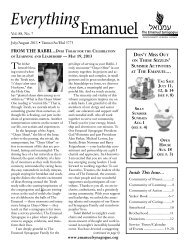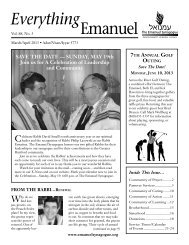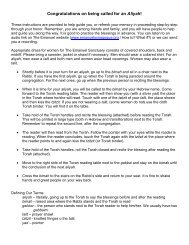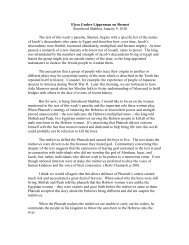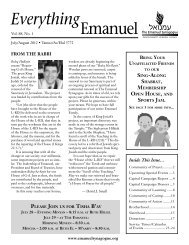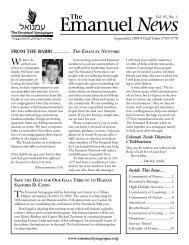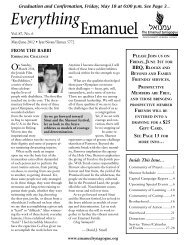Unveiling Ceremony - The Emanuel Synagogue
Unveiling Ceremony - The Emanuel Synagogue
Unveiling Ceremony - The Emanuel Synagogue
You also want an ePaper? Increase the reach of your titles
YUMPU automatically turns print PDFs into web optimized ePapers that Google loves.
<strong>The</strong> <strong>Unveiling</strong> <strong>Ceremony</strong><br />
Adapted by Francene Turken Weingast and Rabbi David Small with permission from How to Do an<br />
<strong>Unveiling</strong> <strong>Ceremony</strong>, by Rabbi Edward Feinstein, Valley Beth Shalom, Encino California. Selections also come from A<br />
Rabbi’s Manual edited by Jules Harlow, published by the Rabbinical Assembly 1965, and <strong>The</strong> Rabbinical Assembly Rabbi’s<br />
Manual by Rabbi Perry R. Rank and Rabbi Gordon M. Freeman, 1998.<br />
Introduction<br />
It has long been a custom of the Jewish People to place a marker on a gravesite. <strong>The</strong> marker is made of<br />
some permanent material— usually stone—and contains the Hebrew and English name of the deceased<br />
and the date of death. It may also contain the date of birth, some very brief description of the deceased,<br />
or a phrase of prayer. Near the top of the marker the Hebrew acronym meaning “Here is interred”)<br />
is inscribed. Near the bottom of the marker are the letters (meaning “May his/her soul be<br />
gathered up in the bond of life.”) This marker represents our conviction that the life of a person does not<br />
evaporate when the body dies. Some significant part of the person lives on among family, friends and<br />
community. Establishing and dedicating this memorial stone is an act of K’vod haMet, honoring the<br />
dead; it often helps with rachamim avelim comforting the mourners, as well.<br />
It has also become customary to gather some time after the death and burial to “unveil” and dedicate the<br />
marker. This ceremony is a strong customary practice or minhag. <strong>The</strong>refore, it is open to our own<br />
variations and inventions. While the presence of clergy is not required, Rabbi Small, Cantor Cohn and<br />
Mr. Pinchover are available and willing to lead an unveiling ceremony. To schedule an unveiling<br />
ceremony, contact Rabbi Small. If you are motivated to conduct it yourself, provided that it is more<br />
convenient for you to do so, Rabbi Small will be happy to coach you.<br />
<strong>The</strong> unveiling is generally done any time between the end of shiva and the end of the first year. If you<br />
cannot do so because of weather or family schedules, you may wait longer. Most families schedule the<br />
unveiling ceremony at a time they are available to gather at the gravesite. Often family and friends<br />
gather for a light meal after the ceremony.<br />
<strong>The</strong> Purpose of the <strong>Unveiling</strong> <strong>Ceremony</strong><br />
Time has passed since the death. <strong>The</strong> shock has worn off. <strong>The</strong> pain of loss is still very real, but it has<br />
changed. We have begun to learn to live without the regular presence of our loved one. We have begun<br />
to find our way back into life again.<br />
<strong>The</strong> unveiling ceremony gathers us together at the gravesite to recall what is immortal and lasting in this<br />
life. We can talk about our loved one with a different spirit than the painful words of eulogy. We may<br />
talk of what we miss most in our loved one’s life. We may celebrate what was triumphant and unique in<br />
this life. We may laugh at their humor, feel the warmth of their love, bring close their wisdom, recall the<br />
moments we most cherish, and cry at the loss.<br />
1
Preparing for the <strong>Ceremony</strong><br />
1. Ask members of the family and close friends to prepare a few words recalling your loved one. This is<br />
not a eulogy, but a brief reflection on the person we miss.<br />
• What one moment best reveals their character?<br />
• What part of them will you never forget?<br />
• In what did your loved one find greatest joy?<br />
• What did you learn from this life?<br />
2. Bring a bagful of stones to place on the gravesite (one per person). This is an old Jewish tradition<br />
showing that we have visited the gravesite to recollect the memory of our loved one. You can use either<br />
ordinary garden or driveway gravel, or decorative polished stones. <strong>The</strong> stones express the lasting quality<br />
of our loving memory<br />
<strong>The</strong> <strong>Ceremony</strong><br />
1. Gather at the gravesite. Bring everyone gathered close together. <strong>The</strong> ceremony is brief; most people<br />
can stand through it. Begin with a few words of poetry or prayer to set the mood. We have come to a<br />
special place to recall what is eternal in our loved one’s life. You may look in a synagogue prayer book<br />
or the booklet of prayer provided by the memorial park or find one from another source of your<br />
choosing.<br />
2. Remove the cover and read the marker. This is usually done by the children of or someone very close<br />
to the deceased. Say the following:<br />
In the name of the family of _______________________ and in the presence of his/her family<br />
(and friends) we consecrate this monument to his/her memory as a token of our love and respect<br />
<br />
T’hi Nishmato (Nishmatah) tzerura b’tzror hachayim<br />
May his (her) soul be gathered up in the bond of life.<br />
<br />
3. Ask those gathered to share their words of memory of your loved one. Be patient. Not everyone<br />
speaks with fluency and grace. Let everyone who wishes share a reflection and a memory. After<br />
memories are shared say the following:<br />
Almighty God, eternal Creator, we are thankful for the life of ______________________, for the<br />
years which he/she was granted and for the privilege of having shared those years. May the<br />
memory of his/her . . . (incorporate some of the descriptions given for example, sense of humor,<br />
dedication to family, generosity, etc.) . .continue to inspire us, that we may live a better life. Oh<br />
God, help all who mourn _____________________________ honor his/her memory through our<br />
daily lives. Comfort us and grant us strength, for You are our Rock and Redeemer. Amen.<br />
2
5. Other prayers that can be said:<br />
A thousand years, in the sight of our eternal and merciful God, are but a day, the years of our life<br />
but a passing hour. God grants us life and life God has taken away; praised be God’s name.<br />
__________________________ has been taken from our midst. We are pained by the gap in our<br />
lives. Yet love is strong as death; the bonds love creates are eternal. And ours is the blessing of<br />
memory, through which the lives of our departed continue to be with us.<br />
4. Read the prayer El Maley Rachamim* in Hebrew (if you are able) and English, and be sure to include<br />
the name of the deceased.<br />
Man<br />
<br />
<br />
<br />
parentsnamesname<br />
<br />
<br />
<br />
<br />
<br />
El maley rachmim, shochen bam’romim ham’tzeh m’nucha n’chona al cnafey hash’china. B’ma-a lot<br />
k’doshim ut’horim c’zhar harkiyah mazhirin et nishmat [name] ben (man)/bat (woman) [parents’<br />
names] shehalach [woman – hal’chah ] lolamo [woman - l’olamah] ba-avur sheh [your name] yiten<br />
tz’dakah ba-ad hazkarat nishmato [woman – nishmatah] , b’gan eden t’hey m’nuchato [woman –<br />
m’nuchatah], ana ba-al harachamim yastirehu [woman – yatirehah] b’seter c’nafav l’olamim v’yitzror<br />
b’tzror hahayim et nishmato [woman – nishmatah], Adonai hu nachalato [woman – nachalatah]<br />
v’yanuach [woman - v’tanuach] b’shalom al mishcavo [woman – mishacavah]. V’nomar amen<br />
Woman<br />
<br />
<br />
<br />
parents’ namesname<br />
<br />
<br />
<br />
<br />
3
Oh God, exalted and full of compassion, grant perfect peace in Your sheltering Presence, among the<br />
holy and pure who shine like the firmament, to the soul of ____________________________, who has<br />
gone to his/her eternal home. Master of mercy, we beseech You, remember all the worthy and righteous<br />
deeds that he/she performed in the land of the living. May his/her soul be bound up in the bond of life.<br />
God is his/her portion. May he/she rest in peace. Let us say: Amen.<br />
*(You’ll find this prayer in any prayer book and in the booklet provided by the memorial park.)<br />
5. Read the Mourners’ Kaddish prayer together. (See pages 5 and 6)<br />
6. Distribute the stones and ask the gathered family and friends to place the stones<br />
on the grave marker.<br />
7. You may end with a closing prayer of your choosing (some join hands for this) as you stand facing<br />
the newly dedicated memorial stone.<br />
8. If you are gathering for a meal, announce where people are invited to go. Printed directions from the<br />
cemetery help.<br />
9. It is fine to spend a few minutes at the cemetery wishing each other well, talking, or visiting the<br />
graves of other relatives or friends (after the ceremony).<br />
4
Mourner’s Kaddish<br />
Please note that this page contains the name of God.<br />
If you print it out, please treat it with appropriate respect.<br />
Mourners and those observing Yahrtzeit:<br />
<br />
Yit'gadal v'yit'kadash sh'mei raba (Cong: Amein).<br />
May His great Name grow exalted and sanctified (`Cong: Amen.)<br />
<br />
<br />
b'al'ma di v'ra khir'utei<br />
in the world that He created as He willed.<br />
<br />
v'yam'likh mal'khutei b'chayeikhon uv'yomeikhon<br />
May He give reign to His kingship in your lifetimes and in your days,<br />
<br />
uv'chayei d'khol beit yis'ra'eil<br />
and in the lifetimes of the entire Family of Israel,<br />
<br />
ba'agala uviz'man kariv v'im'ru: Amein<br />
swiftly and soon. Now say: Amen<br />
Congregation and Mourners:<br />
<br />
Y'hei sh'mei raba m'varakh l'alam ul'al'mei al'maya<br />
May His great Name be blessed forever and ever<br />
Mourners and those observing Yahrtzeit:<br />
<br />
Yit'barakh v'yish'tabach v'yit'pa'ar v'yit'romam v'yit'nasei<br />
Blessed, praised, glorified, exalted, extolled,<br />
5
v'yit'hadar v'yit'aleh v'yit'halal sh'mei d'kud'sha B’rikh hu.<br />
mighty, upraised, and lauded be the Name of the Holy One Blessed is He.<br />
<br />
l'eila min kol bir'khata v'shirata<br />
beyond any blessing and song,<br />
<br />
toosh'b'chatah v'nechematah, da'ameeran b'al'mah, v'eemru: Amein<br />
praise and consolation that are uttered in the world. Now say: Amen<br />
<br />
Y'hei sh'lama raba min sh'maya<br />
May there be abundant peace from Heaven<br />
<br />
v'chayim aleinu v'al kol yis'ra'eil v'im'ru: Amein<br />
and life upon us and upon all Israel. Now say: Amen<br />
<br />
Oseh shalom bim'romav hu ya'aseh shalom<br />
He Who makes peace in His heights, may He make peace,<br />
<br />
aleinu v'al kol Yis'ra'eil v'im'ru: Amein<br />
upon us and upon all Israel. Now say: Amen<br />
6


